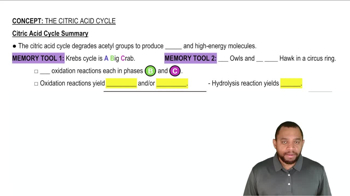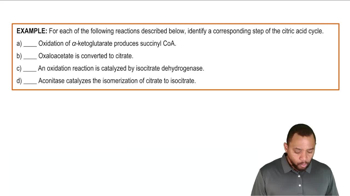Here are the essential concepts you must grasp in order to answer the question correctly.
Citric Acid Cycle
The citric acid cycle, also known as the Krebs cycle, is a series of chemical reactions used by all aerobic organisms to generate energy. It occurs in the mitochondria and involves the oxidation of acetyl-CoA to produce ATP, NADH, and FADH2. Understanding this cycle is crucial for analyzing how carbon atoms are transformed and released during cellular respiration.
Recommended video:
Citric Acid Cycle Summary Concept 12
Decarboxylation
Decarboxylation is a biochemical reaction that removes a carboxyl group from a molecule, releasing carbon dioxide (CO2) as a byproduct. In the citric acid cycle, decarboxylation occurs at specific steps, such as the conversion of isocitrate to alpha-ketoglutarate and alpha-ketoglutarate to succinyl-CoA, effectively reducing the number of carbon atoms in the cycle.
Recommended video:
Naming Dicarboxylic Acids Concept 3
Acetyl-CoA
Acetyl-CoA is a central metabolite in the citric acid cycle, formed from carbohydrates, fats, and proteins. It consists of a two-carbon acetyl group attached to coenzyme A. The entry of acetyl-CoA into the cycle initiates the series of reactions that ultimately lead to the release of carbon atoms, highlighting its role in carbon atom reduction during energy production.
Recommended video:
Phase B - Succinyl CoA Formation Example 2
 Verified step by step guidance
Verified step by step guidance Verified Solution
Verified Solution



 :50m
:50m